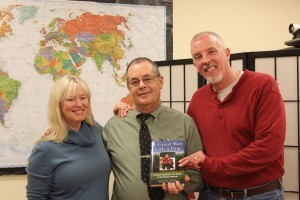Lea Wait's Blog, page 262
April 28, 2016
Dream Vacation?
Jessie: Eagerly awaiting tomorrow’s start of the Malice Domestic Conference!
Everyone has an idea of their dream vacation. For myself and a lot of the writers I know, some of the best vacations involve attending writing conferences. I realise a working vacation is not everyone’s idea of a great time but I promise, for many of us it’s true.
Because our work is done in solitude, we have to seek out opportunities to interact with other people in our industry. Writing conferences function sort of like an office water cooler for us. Despite the fact that many of us would proudly claim the label introvert, we still enjoy spending time with people who have an idea of what it is like to be in this crazy business. In fact, when writers get together, most of us are having such a good time we are quite outgoing.
It does the heart good to talk with people who really understand why an agent requesting the first fifty pages of your manuscript is enough to keep you going for a couple more years. It is wonderfulto have the rare chance to compare notes about the writing process, craft, the state of the industry and how to reach new readers.
Putting faces to names is part of the fun too. Often writers have online correspondances with each other long before they meet in person. Having the opportunity to visit live with people you feel like your already know, but have never meet, is such a treat. Meeting readers, especially those who have commented on your blog posts, or have sent you fan mail, is truly wonderful.
There’s also the fun of star spotting. Conferences are full of other writers you respect and to whom you have written fan mail of your own. At conferences you can listen to them share their own stories from seats on panels or you may even be so lucky as to run into them in an elevator or at the bar.
So, if you ask a writer about their vacation plans, don’t be surprised to hear them gleefully replying they are headed for a long weekend of staying indoors and talking shop in a city not know for its tourism.
Readers, do you love to attend conferences in your industry? Writers, do you have favorite conferences you’d like to recommend?
April 26, 2016
The First RFD Carrier in Town
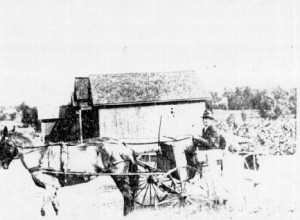
Fred Gorton on his RFD route
Kathy Lynn Emerson/Kaitlyn Dunnett here. What follows is not a Maine story, although I suspect similar events took place in this state. It is an account of my grandfather’s career working for the post office in rural Sullivan County, New York, an area that is geographically similar to central Maine.
Fred Gorton was the first RFD carrier in Liberty, New York. He started on March 2, 1908, when the whole idea of Rural Free Delivery was new. The mailmen, or carriers, who made $67.50 a month, provided their own horses and wagons and feed for the horses, too. In those early days, the RFD carrier usually worked from 10:30 until 4:30. Fred traveled a route twenty-seven miles long. At the end of the day he emptied all the mail he’d collected into a big tray in the post office in Liberty.
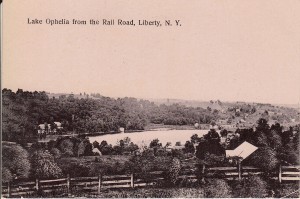 Fred had a horse named Old Dobbin for the first five years he worked this job. His first wagon had no top. He used an advertising umbrella for shelter. One day, Dobbin bolted and the umbrella sailed off into the air and landed in Lake Ophelia, never to be seen again. In the winter of 1910, Fred decided to drive Old Dobbin the whole length of Hilldale Lake on the ice in the hope of getting his name in the paper. In doing so, he skipped two boarding houses on his route. He never tried that again!
Fred had a horse named Old Dobbin for the first five years he worked this job. His first wagon had no top. He used an advertising umbrella for shelter. One day, Dobbin bolted and the umbrella sailed off into the air and landed in Lake Ophelia, never to be seen again. In the winter of 1910, Fred decided to drive Old Dobbin the whole length of Hilldale Lake on the ice in the hope of getting his name in the paper. In doing so, he skipped two boarding houses on his route. He never tried that again!
Fred knew all his customers by name and sometimes he was asked to play cupid. A new schoolteacher once asked him to deliver a sealed letter to her beau, but she warned him not to leave it in his mailbox, but to deliver it by hand. A man asked a similar favor. He was afraid his mother would see his love letters before he got home from work, so he asked Fred to leave them in a neighbor’s mailbox.
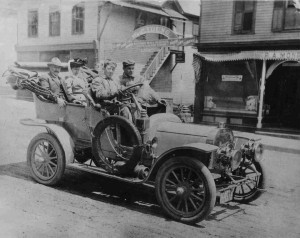
the first automobile in Liberty, New York with my maternal grandparents as passengers
In 1915, Fred bought at Model T Ford for $467.50. It came in a boxcar on the O&W Railroad. After two days of instruction, he drove it on his own. He had to crank it to start it, and when he had a blow out, he had to jack the car up, patch the inner tube, and blow it up again with a foot pump. Fred drove the Model T for three summers on the RFD route, but for four months every winter he still had to use a horse. They didn’t plow the roads in those day. From late December until mid-March, he hitched the horse to a sleigh.
Another horse Fred used on the RFD was named Roxy. He hired a livery horse every Thursday to spell her, but she made the trip five days a week nearly all winter. Some days he could use the horse part way, leaving her with someone while he made another loop through the fields and coming back again for her when he was done. One day he caught the train at Taylor’s Crossing and rode it back to Liberty with the mail.
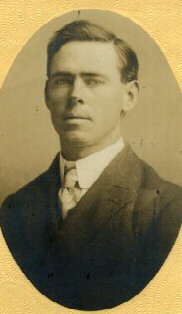 On February 19, 1916, Fred had the most difficult trip of his career. The sleigh upset twice, and he lost all his horse feed in the field. Then, when Roxy wouldn’t stand up, he jerked on her reins and broke the turret off the harness. By the time he arrived at Alvin Brown’s house, the road was completely impassable. He put Roxy in Brown’s barn, put all the mail in a sack, and went on by foot. It was just after noon when he started out from Brown’s. He stopped for dinner at one house on his route and left mail for eight patrons there. Another patron met him with an ox sled, breaking the road for him, and several others offered him hot drinks and food. Finally, after all the mail was delivered, Fred returned to Alvin Brown’s. The Browns had unharnessed Roxy, so while they were hooking her up again, Fred rested and visited. He finally got back to the Liberty post office at 7:05 PM, so lame from walking that he felt it for two days. He’d walked seventeen miles over his RFD route in snow two feet deep.
On February 19, 1916, Fred had the most difficult trip of his career. The sleigh upset twice, and he lost all his horse feed in the field. Then, when Roxy wouldn’t stand up, he jerked on her reins and broke the turret off the harness. By the time he arrived at Alvin Brown’s house, the road was completely impassable. He put Roxy in Brown’s barn, put all the mail in a sack, and went on by foot. It was just after noon when he started out from Brown’s. He stopped for dinner at one house on his route and left mail for eight patrons there. Another patron met him with an ox sled, breaking the road for him, and several others offered him hot drinks and food. Finally, after all the mail was delivered, Fred returned to Alvin Brown’s. The Browns had unharnessed Roxy, so while they were hooking her up again, Fred rested and visited. He finally got back to the Liberty post office at 7:05 PM, so lame from walking that he felt it for two days. He’d walked seventeen miles over his RFD route in snow two feet deep.
All of my grandfather’s story, one of my earliest writing projects, is online as The Life of a Plodder: Fred Gorton’s 95 Years. The index page is here: Life of a Plodder
Kathy Lynn Emerson/Kaitlyn Dunnett is the author of over fifty books written under several names. She won the Agatha Award in 2008 for best mystery nonfiction for How to Write Killer Historical Mysteries and was an Agatha Award finalist in 2014 in the best mystery short story category for “The Blessing Witch.” Currently she writes the contemporary Liss MacCrimmon Mysteries (The Scottie Barked at Midnight) as Kaitlyn and the historical Mistress Jaffrey Mysteries (Murder in the Merchant’s Hall) as Kathy. The latter series is a spin-off from her earlier “Face Down” series and is set in Elizabethan England. Her websites are www.KaitlynDunnett.com and www.KathyLynnEmerson.com
April 25, 2016
A Walking Tour of Littlehope, Maine
Jen Blood here, taking a break from full-on immersion in the next novel to spend a little time at Maine Crime. THE DARKEST THREAD is technically the first book in a new series featuring K-9 search and rescue handler Jamie Flint, but it’s actually a spin-off of my Erin Solomon novels, where Jamie was first introduced to readers. Now that I’m back in that world so much these days, I thought it would be fun to give readers a glimpse into the locales that have served as inspiration.
As a writer, I don’t think I’m that different from most who make their living crafting fictional worlds. I get inspiration from the world around me: the people, the places, the views, the animals. Having grown up in Midcoast Maine, I was never short on inspiration; there are plenty of eccentric characters and picturesque destinations to go around in these parts. While Erin’s hometown of Littlehope, Maine, is technically fictional, most people from this area agree that the little fishing village seems awfully familiar. That’s because Littlehope is an amalgamation of a handful of towns around here, and many of the businesses mentioned are places I frequent…well, frequently. Here are a few of them.
THE LOYAL BISCUIT
In the Erin Solomon series, the go-to destination for Erin’s dog Einstein is the Loyal Biscuit — a super-cool, actual pet boutique owned by Heidi Vanorse Neal, with locations in Rockland, Camden, Belfast, and Waterville. My pup Killian gets most of his food from the Biscuit, and has become so hooked on their duck feet that I’m pretty sure some form of doggie crack is a main ingredient. Heidi and the Biscuit have won a whole parcel of awards, the store has its own treat line as well as a line of dog toys, and it has the best crew of workers this side of the Mason-Dixon line. Whether you live in Maine or are just visiting, a must-stop destination for any animal lover is definitely The Loyal Biscuit.
DORMAN’S DAIRY DREAM
Since it first opened in 1951, the little ice cream stand on Route 1 headed north toward Rockland has become a mainstay. Now, every April without fail the whole region waits with bated breath for the day when the Open sign returns at Dorman’s Dairy Dream and another season of amazing ice cream is upon us. They’re not open on Sundays and the lines are usually substantial, but no one seems to mind. I can still remember being sunburned and shivering after a long day at the beach, so sleepy I could barely keep my eyes open, standing in line waiting for my peppermint stick with chocolate sprinkles on a homemade waffle cone (which I actually, incidentally, had just this afternoon). When I was writing SINS OF THE FATHER, the second Erin Solomon novel, it seemed only natural that one of the places Diggs and Erin would hit on their way out of town would be Dorman’s.

Dorman’s Dairy Dream, as captured by artist Robert Colburn.
LITTLEHOPE
While it’s true that Littlehope is actually an amalgamation of a whole slew of towns here in Midcoast Maine, the original inspiration is a little fishing village on a peninsula at the end of Route 97 called Friendship. When I first started writing ALL THE BLUE-EYED ANGELS back well over a decade ago, I was house sitting regularly for a couple who lived in a cute little cape on Tamarack Lane. In fact, the character of Noel Hammond is loosely based on the guy I house sat for, and Noel’s house is a dead ringer for that cute little cape. The general store, the public landing at the bottom of the steep hill, and the side roads that follow the ocean are all taken from Friendship, as is its reputation as a tough, independent little town that makes the news every so often for its lobster wars and the occasional domestic dispute.
I always think it’s fun to learn more about the places my favorite writers have patterned their settings after. What are your favorite fictional towns, and the characters who walk their streets?
Jen Blood is author of the bestselling Erin Solomon mysteries and the upcoming Flint K-9 novels. You can learn more by visiting her website, at www.jenblood.com.
April 24, 2016
Have I Been Looking At Things Backwards?
 Vaughn Hardacker here: In 2002 I realized that there was more to writing than just sitting down and putting words onto a page. I had to learn the craft. One of the first things I learned was that every story, whether it a mystery/crime story, a romance, or even a children’s story must have as a bare minimum, two characters: a protagonist and an antagonist. I set out developing two characters for my first Houston/Bouchard novel, SNIPER. I started with my hero, AKA the protagonist, Michael Houston and then my villain, the antagonist.
Vaughn Hardacker here: In 2002 I realized that there was more to writing than just sitting down and putting words onto a page. I had to learn the craft. One of the first things I learned was that every story, whether it a mystery/crime story, a romance, or even a children’s story must have as a bare minimum, two characters: a protagonist and an antagonist. I set out developing two characters for my first Houston/Bouchard novel, SNIPER. I started with my hero, AKA the protagonist, Michael Houston and then my villain, the antagonist.
In an effort to refresh my knowledge of the craft, I started reading DRAMATICA: A New Theory of Story by Melanie Anne Phillips and Chris Huntley (available at dramatica.com). The one thing that immediately struck me was in their discussion on characters, they maintain that in any story there are several distinct types of characters: the main character, the protagonist, and the antagonist. They define each as:
Main Character: The player through whom the audience experiences the story first hand.
Protagonist: The prime mover of the plot.
Antagonist: The character diametrically opposed to the protagonist.
In many stories, the hero is a combination of main character and protagonist. When taken in the context of the definitions above it is possible to argue that in most cases (especially in mystery and crime/thriller fiction) the villain better fits the definition of the protagonist. It is the villain, not the so-called hero, who is the prime mover of the plot (this is possibly more likely in the thriller genre). It is the villain who acts first forcing, for one reason or another, the hero to react. Throughout much of the story it is the actions of the villain that are the prime movers of the plot.
A couple of examples:
In Bram Stoker’s classic romantic tale of horror, Dracula, it is the villain, Count Dracula who is the prime mover of the plot, not the hero, Doctor van Helsing. Dracula moves, van Helsing reacts.
In every James Bond thriller it is the villain (Dr. No, Ernst Stravo Blofeld, etc.) who acts first and Bond who reacts.
In each of the cases above, I would argue that it is the villain who is the true protagonist and the antagonist is the main character or the hero. Who in your story is the protagonist; who is your antagonist; and who is your main character?
________________________________________________________
Vaughn C. Hardacker’s latest thriller, BLACK ORCHID, was released by Skyhorse Publishing, Inc. in March 2016. Skyhorse has also placed is fourth thriller, WENDIGO, under contract. He lives in SAtcokholm, ME where he is currently working on several new projects.
April 22, 2016
Weekend Update: April 23-24, 2016
 Next week at Maine Crime Writers there will be posts by Vaughn Hardacker (Monday), Jen Blood (Tuesday), Kathy Lynn Emerson/Kaitlyn Dunnett (Wednesday), Jessie Crockett (Thursday), and John Clark (Friday).
Next week at Maine Crime Writers there will be posts by Vaughn Hardacker (Monday), Jen Blood (Tuesday), Kathy Lynn Emerson/Kaitlyn Dunnett (Wednesday), Jessie Crockett (Thursday), and John Clark (Friday).
In the news department, here’s what’s happening with some of us who blog regularly at Maine Crime Writers:
Lea Wait: Thursday evening, April 28, from 5 p.m. until 7 p.m. my husband Bob (with his paintings) and I (with my books and antique prints) will be at The Bee’s Knees (617 Colonial Avenue) in Norfolk, Virginia, talking about — what else? Painting and Writing. Hope to see some of you there! Then I’m heading to Bethesda, Maryland, to Malice Domestic, where Kathy Lynn Emerson, Barbara Ross and I will be on the “Murder in New England” panel Saturday afternoon April 30 at 2:00. Exciting week!
An invitation to readers of this blog: Do you have news relating to Maine, Crime, or Writing? We’d love to hear from you. Just comment below to share.
And a reminder: If your library, school, or organization is looking for a speaker, we are often available to talk about the writing process, research, where we get our ideas, and other mysteries of the business. Contact Kate Flora: mailto: kateflora@gmail.com
April 21, 2016
No Bystander Effect Here
By Brenda Buchanan
The April 10 headline yanked me into the story.
‘No hesitation’ as Maine man rescues mother, 2 kids from sinking car.
The heroes were a 60ish couple from Steuben, Leonard and Rosemary Wallace, who were doing a little early-season trout fishing at Fox Pond in Township 10 when a car went airborne at a sharp curve in Route 182 and wound up in the 48 degree water.
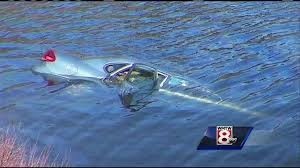
The car, underwater in Fox Pond
The vehicle missed the Wallaces by maybe a foot. Despite the close call they sprang into action. Leonard waded in until the pond reached his armpits, wrenched open the car’s rear door and somehow managed to free both children and their mother. He handed the kids off to his wife, who attempted to flag down passing motorists while struggling to get a 911 call to go through in a virtual cell phone dead zone. When no one stopped to assist, she fired up their Grand Am and dug out some blankets to keep the freezing family and her adrenaline-fueled husband warm until an ambulance arrived.
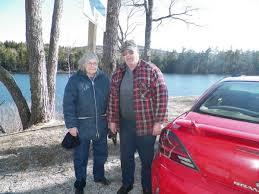
Rosemary and Leonard Wallace next to the pond where they saved three lives
The story got top billing in the media for several days, as did the unfortunate follow-up news that the mother—who was on her way home from getting treatment for her drug addiction—had been drinking. The Wallaces have since been honored by the Maine Legislature. The children were taken from their mother’s custody by the Department of Health and Human Services. I hope she gets the help she needs, which can be a complicated proposition, especially in Maine’s rural reaches.
Ten days later, I remain moved by the selfless heroism of the Wallaces. If I’d been sitting on that embankment that day, would I have dropped my fishing pole and jumped in after the sinking car? I’d like to think so, but until tested, who can say for sure?
Less than two weeks before the Black Woods Road incident I’d been pondering the same question from a different perspective.
Winston Moseley, the psychopathic serial killer convicted of the 1964 rape and murder of Kitty Genovese in Queens, New York, died on March 28. Moseley’s obituary recounted that numerous neighbors heard the middle-of-the-night assault but ignored the victim’s screams. That horrific part of the story didn’t become known until weeks later when the New York Times ran a sensational follow-up piece claiming 38 witnesses had turned their backs. That number later was found to have been exaggerated, but the fact remained that plenty of people heard and disregarded Kitty Genovese’s cries, a phenomenon that came to be dubbed “the bystander effect.”
In my books and those by some of my colleagues on this blog, non-cop characters tend to be more like the Wallaces and less like Kitty Genovese’s neighbors. When bad things happen, they dive right in.
Barbara Ross’s protagonist Julia Snowden doesn’t hesitate to get involved when trouble comes to Busman’s Harbor. Maureen Milliken’s Bernie O’Dea considers it her mission in life to wade into controversy and crime. Lea Wait’s Angie Curtis deserves a badge of her own for her crime-solving ways, and Dick Cass’s Elder Darrow (what a great character name, eh?) doesn’t let his troubled past deter him from investigating stuff the cops ignore. (Chris Holm, who delights in breaking rules, writes a protagonist who is neither cop nor crime-solver. His Michael Hendricks is a big-time crime-committer, albeit with a moral center.)
My newspaper reporter protagonist Joe Gale’s vigorous journalistic style inevitably pisses people off, which brings me back to the Maine road where Leonard and Rosemary Wallace saved three lives this month. Readers of this blog who’ve read Cover Story, the second Joe Gale novel, will know Route 182 by its local name—the Black Woods Road.

The Black Woods Road, which winds between Franklin and Cherryfield
In Cover Story, Joe Gale finds himself in big trouble on Route 182 during a January blizzard. With a fearsome antagonist riding his tail Joe skids around sharp curves in near-whiteout conditions—past the very spot where the young mother’s car flew into Fox Pond earlier this month—in a desperate effort to make it through the Black Woods alive.
After this month’s drama, I’ll never drive that road again without thinking of the courageous actions of Leonard and Rosemary Wallace, who saved a troubled Mom and her two babies from a tragic ending, a story Joe Gale and every real-life reporter in Maine would have shuddered to write.
Brenda Buchanan’s Joe Gale mysteries feature an old-school reporter with modern media savvy who covers the Maine crime beat. The first three Joe Gale books—Quick Pivot, Cover Story and Truth Beat—are available in digital format wherever ebooks are sold. Brenda can be found on the web at www.brendabuchananwrites.com, on Facebook at https://www.facebook.com/BrendaBuchananAuthor and on Twitter at @buchananbrenda
April 20, 2016
Writing What I Know … My Home’s History
Lea Wait, here. Stories of the past speak to me. Historical novels have always been among my favorites, and I write books set in nineteenth century Maine for ages eight and up in addition to my two mystery series, many of which have slices of history included, either as backstory or as clues to the solutions of murders today.
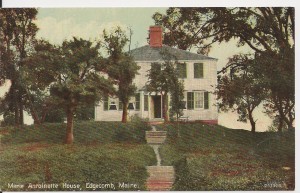
Photo Postcard of my home from 1900
What you may not know is that several of my books have direct connections to the history of the house I live in.
My home was built on an island in Maine in 1774 as a home for a Captain Decker and his wife and daughter. After the captain’s death his son-in-law, Captain Stephen Clough, bought the home, and lived there with his wife, his five children, and his mother-in-law. (In those days women couldn’t inherit property. But that’s another story!) Because of Jefferson’s Embargo, many captains, including Clough, lost their jobs. The house was left empty for a number of years as the family moved north in search of other ways to make a living. In the 1830s the house was briefly owned by a man who moved it (legends say twenty-yoke of oxen pulled it across the frozen river and up a steep hill) to the mainland. Shortly after that it was bought, in turn, by three different captains (all brothers), one of whom was a widower who married one of Stephen Clough’s granddaughters, bringing the house back into the original family. My family bought it in 1955.
So — what has that history to do with my books?
Sally Clough, the young sixteen-year-old bride in my Stopping to Home (1806), was the oldest child of my house’s second owner.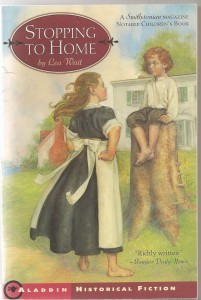
Reverend Adams, in Wintering Well (1819-1820), was the husband of one of Sally’s nieces.
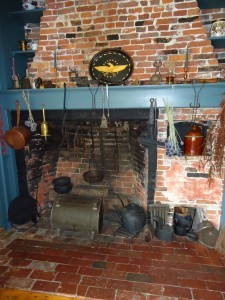
Lea’s Kitchen Fireplace
In Shadows on the Coast of Maine I tell the story of a house moved from an island to the mainland, and the original fireplace closed to make way for a modern stove. In the book my characters open that old fireplace and find … well, you’d have to read the book. But my mother and grandmother and I opened the wall in our kitchen and found … a lot of dirt, and the original crane in the fireplace.
In Living and Writing on the Coast of Maine I write more about the people who lived in this house; how they kept warm in the winter, and how the rooms in their house and ell and barn were used in the past.
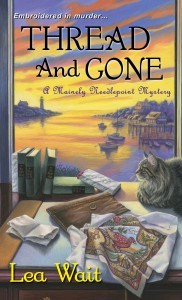 And in my most recent book, Thread and Gone, one of my main characters is a descendant of Captain Stephen Clough … and the mystery involves Clough’s involvement in trying to save Marie Antoinette, or other royalists, during the French Revolution. My historical notes explain what happened. My plot adds a few twists to the history.
And in my most recent book, Thread and Gone, one of my main characters is a descendant of Captain Stephen Clough … and the mystery involves Clough’s involvement in trying to save Marie Antoinette, or other royalists, during the French Revolution. My historical notes explain what happened. My plot adds a few twists to the history.
Are there more stories to be told connected to my home? Quite possibly. In (almost) two hundred and fifty years, a house hold many secrets and tells many tales. And a writer often writes about what she knows. Or imagines.
Lea Wait writes the Shadows Antique Mystery series and the Mainely Needlepoint series, and historical novels for ages eight and up set in nineteenth century Maine. For more information about her books, see her website.
April 19, 2016
Novel Architecture

I suppose this is one way to pray for inspiration.
Chris Holm here. Though Library Week has officially passed, I wanted to take a moment to acknowledge the role libraries played in making me who I am. Money was tight when I was young, and my love of books hit early and hard. As a consequence, libraries were how I kept my brain (and soul) fed. I doubt I’d be a writer today if it weren’t for them, and the wonderful people (librarians, volunteers, readers, and writers) who populate them.

I’d like to buy a vowel.
That’s why I’m always delighted to give back whenever I can. Library events are among my favorites in this business, because they always feel a bit like coming home. Two weeks ago, I was lucky enough to read at the Portland Public Library. (Thanks to everybody who came out!) I’ve got three library events scheduled for the coming months. A couple more I’m still firming up. (Check the Appearances section of my website’s sidebar if you’re interested in attending any.) And if you’re a librarian within reasonable driving distance of Portland, I’m always looking to add more.

G’night. Sleep tight.
Since we’re on the topic of wondrous places that feed both brain and soul, I thought I’d share with you one of my favorite local haunts: Portland Architectural Salvage.
Don’t let the name fool you. This ain’t some bland home-improvement center. What it is is a ramshackle, four-story maze made entirely of writing prompts. Creepy statuary? Check. Stained glass recovered from Masonic temples? Check. Terrifying demon masks that will haunt your dreams for years to come? SO VERY CHECK.
I go whenever I feel like I need to recharge my creative batteries. After a few hours spent wandering around, I always come home brimming with ideas. Pictures, too—including every photo in this post, and dozens more besides.
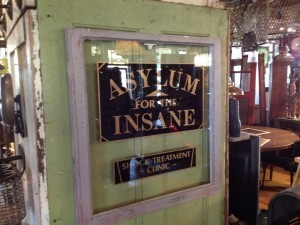
My wife’s seen too many horror movies to let me buy this.
Understand, I’m not affiliated with Portland Architectural Salvage in any way. In fact, I’m probably the sort of customer that drives them bonkers, because I rarely buy anything. (Turns out, stone lions from Tuscany are expensive.) But if your writing needs a jolt, I highly recommend you check them out. You can also like them on Facebook or follow them on Instagram if you want to inject a little mystery and intrigue into your social media feeds. Who knows? You might even get a story out of it.
April 18, 2016
Who Killed Cranium 17?
I was on a plane recently (something I’ve spent far too much time doing lately) and got into the usual conversation with a seatmate.
“What do you do?” he said.
“I’m a writer.”
“What do you write? Anything I would have read?”
“Crime fiction, mostly. Murder mysteries.”
“Oh, I can’t read those. All the violence just makes me sick.”
Aside from the disheartening sense that we weren’t going to have anything else to talk about for the rest of the twelve-hour flight, it did set me thinking why, with all the actual violence in the world, I was engaged in creating stories where violence was such a central component. Was I, in effect, just adding more violence into a world already surfeited with it? And, if so, how could I justify that?
The earliest written tale we have is the Babylonian epic Gilgamesh, created over 3000 years ago. Incised on the twelve clay tablets, among paeans to the beauty of the king of Uruk and episodes of droit du seigneur, is an ode to violence, from the first fight between Gilgamesh and Enkidu to their mutual quests, in which various monsters, animal guardians, and gods are attacked and/or dispatched. So at least we’re working out of some sort of tradition. Violent stories are as old as writing. As is murder, apparently.
In 2015, field researchers found a 430,000 year old skull in the Atapuerca Mountains in Northern Spain, at the bottom of a 40 foot pit.
This skull, catchily named Cranium 17, was different from all the other skull bones in the pit because it showed two holes in the forehead, just above the left eye. CT scans and forensic analysis demonstrated that the skull’s owner died from these wounds and that the positions and angles of the impacts indicated that the blows were struck, not incurred in a fall. That is, the person whose skull this was was murdered. Nearly half a million years ago, we were killing each other.
So do we accept that violence is an inherent part of being human?
I suspect one of the reasons crime writers are drawn to violence is that we recognize the violent tendencies in ourselves, in all of us. Even the mildest mannered rage in traffic, flare when someone angers them, curse an unlucky break. By creating situations and characters that partake of violence, sometimes in extreme forms, are we sublimating our own violent tendencies? Or bleeding off that emotion somehow?
Or maybe we write about it so we can experience it, indulge it, vicariously. Maybe we are voyeurs of an experience we don’t want for ourselves but are avid to see, to understand, to show to others.
My belief is that senseless violence frightens us most. When the trigger is a perverted interpretation of a religious impulse we do not empathize with or the pure evil of a psychopathic personality that we cannot comprehend, we shy from it. But by writing about it, we can certainly try to understand.
But the interest for me in writing about crime and violence, as it is for most interesting writers, I think, is the why of the violence, not the who or the what. Descriptions of fistfights, gun battles, car chases, even torture, get boring very quickly. But the human pressures, the emotions, acts, or desires that provoke someone into the violent act? We all want to know the causes, root and immediate, that sling the punch, that fire the gun.
What I wish I’d answered to my interlocutor was this: my writer’s interest in violence is motive, which is to say character. I write my stories to find out not what happened but why. Is this every writer’s motive? I would never suggest that. But I believe it’s part of why we choose to write what we do.
And seriously. Wouldn’t you like to know why Cranium 17 was murdered? And by whom? Solve a murder mystery half a million years old?
April 15, 2016
Weekend Update: April 16-17, 2016
 Next week at Maine Crime Writers there will be posts by Barb Ross (Monday), Dick Cass (Tuesday), Chris Holm (Wednesday), Lea Wait (Thursday), and Brenda Buchanan (Friday).
Next week at Maine Crime Writers there will be posts by Barb Ross (Monday), Dick Cass (Tuesday), Chris Holm (Wednesday), Lea Wait (Thursday), and Brenda Buchanan (Friday).
In the news department, here’s what’s happening with some of us who blog regularly at Maine Crime Writers:
from Kathy/Kaitlyn: This isn’t writing news, or mystery news, but it sure does relate to Maine. Saturday is the Kenduskeag Stream Canoe Race in Bangor, Maine. It’s a little hard to explain the appeal of watching canoes and kayaks tip over at Six Mile Falls, but this event is celebrating its fiftieth year and, for those Mainers who don’t make the trek to Bangor to watch in person, it’s broadcast live on channel 5, starting at 10 AM. I’ll try to find a video clip and put up a link later.
Murder by the Minute: On Sunday April 17th from 5-7 p.m., Maine crime writers Kate Flora, Brenda Buchanan, Maureen Milliken, Jen Blood, and Bruce Coffin will be at Bull Feeney’s Pub at 375 Fore Street in Portland, reading from our work. We’ll be joined by other Maine crime writers and hope you’ll come and join us and get a sneak peek at what we’re up to.
Here are a couple of photos from the launch event for A Good Man with a Dog, at the Pittsfield Library, Kate Flora, Roger Guay (holding a copy of his memoir), Bruce Coffin, and a clever yellow lab named Saba.
An invitation to readers of this blog: Do you have news relating to Maine, Crime, or Writing? We’d love to hear from you. Just comment below to share.
And a reminder: If your library, school, or organization is looking for a speaker, we are often available to talk about the writing process, research, where we get our ideas, and other mysteries of the business. Contact Kate Flora: mailto: kateflora@gmail.com
Lea Wait's Blog
- Lea Wait's profile
- 509 followers






